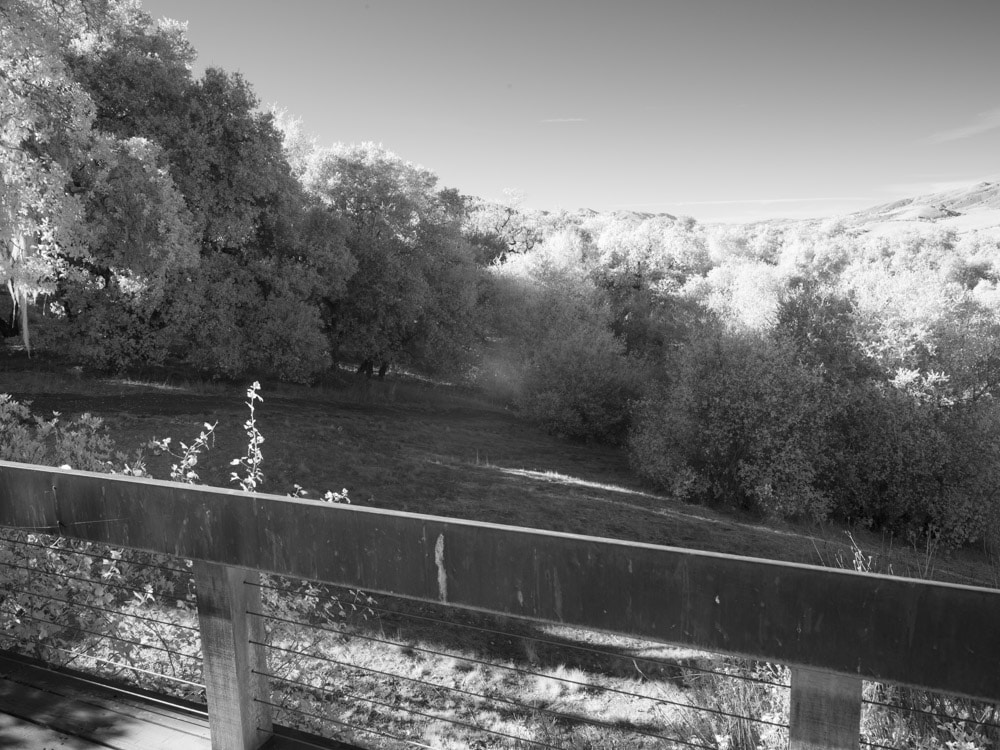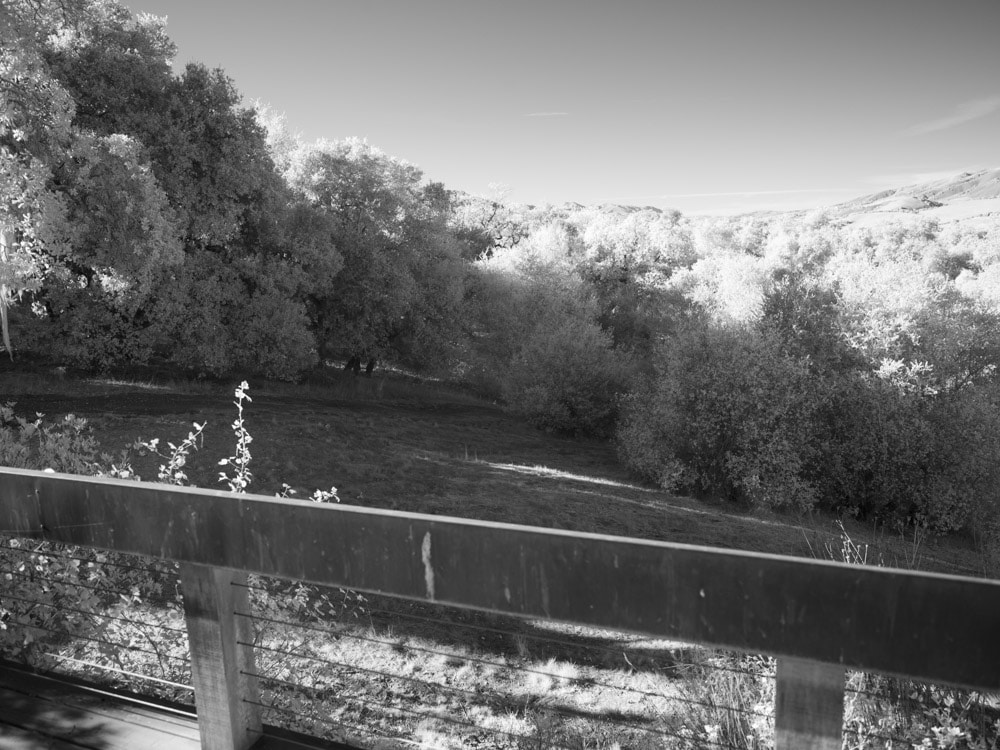Yesterday, I received a Fujifilm GFX 50R back from LifePixel, who had modified it with a 720 nm infrared conversion. The modification consists of the removal of the IR-blocking filter — aka hot mirror — and its replacement by a filter that blocks visible light and passes infrared light with wavelengths shorter than about 720 nanometers. I’m going to be writing about how the modified camera performs, but that’s not the subject of this post. There is a difficulty of infrared photography that I need to deal with. It applies to varying degree to all modified cameras and to many lenses. It is also widely misunderstood.
It’s called hotspotting.
Here’s what it looks like:
See that bright area smack dab in the middle of the picture? That’s the hot spot. Here’s what the scene loks like without it:
These kinds of hotspots are caused by reflections from the image sensor stack bouncing off the elements in the lens and returning to the sensor. They are almost always in the middle of the sensor.
It’s not strictly an IR thing. The same thing can happen with visible light, but the sensor and lens manufacturers deal with it by costing lens elements, and sometime sensor stack elements, with antireflective coatings. Because the manufacturers don’t expect the cameras and lenses to be used in infrared, these coatings are usually not very effective for IR.
A lot of things can affect whether hotspotting is a problem. Here’s my list, and it may be incomplete.
The IR sensitivity of the camera. Generally, the deeper you go into the infrared the worse the hotspotting gets. If you’re using an unmodified camera with a 720 nm lowpass filter over the lens, that’s the best case. A camera modified with a 720 nm filter is usually worse for hotspotting. A 720 nm camera with a 850 mn filter over the lens or a 850 nm camera is even worse.
The lens design. Shorter focal lengths are usually worse than long lenses. Zooms are usually worse at some focal lengths than primes.
The aperture. Wide apertures will show broad, weak hotspots, or none at all. Narrow ones will evince tighter, brighter hot spots.
The focused distance. Usually, if this is an issue, it happens at macro distances. The Coastal Optical 60 mm f/4 has a nasty hot spot even in visible light at some close distances.
The relative brightness of the scene outside the hot spot. The more light there is, the more light will be bouncing around inside the camera, and the brighter the hot spot will be.
The relative brightness of the scene at the hot spot. The darker the subject at the place where the hot spot will be, the easier it will be to see the hot spot.
Antireflective coatings on the modified sensor stack. If the IR reflections from the sensor are attenuated, so will be the hot spot. At least one company, Kolari, sells modified cameras with infrared antireflective coatings. Unfortunately, they won’t modify a GFX 50x that way.
In the next few posts, I will test all the Fuji G-mount primes at long subject distances and various f-stops and report what I find. I’ll do this for the 720 nm modified camera I now have, and I will see if putting an 850 nm filter in front of the lens makes much difference.


In my experience this issue is not limited to unwanted variations in brightness.
When I do color IR work , I find that some lenses that produce acetable results in BW IR with no variantions in brightness will give a zone in the middle of the image with hue variations that are quite difficult to fix in post.
Glad to see a new post!
This is quite an interesting subject. It is quite a quest to look for a hotspotless lens. After so much disappointment, my bets are now on the Schneider Xenon-Emerald line. I still didn’t have a chance to try one, but here is the information that I can share.
The lenses are designed to perform both in the visual and short-infrared range and have BBAR 400-1000. They are offered for long (L) or short (S) working distance, the line comprising: 28mm/2.8 L, 28mm/2.8 S, 50mm/2.2, 100mm/2.8 L and 100mm/2.8 S, all with 43.3mm image circle. Luckily there is one wide angle option. And there are two lenses that can cover 60mm, ideal for MF, one is a normal 60mm/4 and tre other is a close range 80mm/4.
They come in F-mount, which is quite practical. Edmund Optics sells them and you may find detailed information here:
https://www.edmundoptics.com/f/schneider-large-format-f-mount-lenses/14313/
BTW, I am a customer not a salesman. And I hope you can test at least one of these lenses. Your evaluation will be very helpful for all IR users and mostly for those like me living in countries with hard access to such specific equipment.
B&H also sells the Xenon-Emerald lenses, much cheaper.
They look weird, but are the most specific options that I can find.
This is the 28mm L:
https://www.bhphotovideo.com/c/product/843247-REG/Schneider_21_1071606_Xenon_Emerald_Lens_f2_8.html
See this: https://blog.kasson.com/gfx-50s/co-60-4-uv-vir-ir-on-ir-modified-gfx-50r/